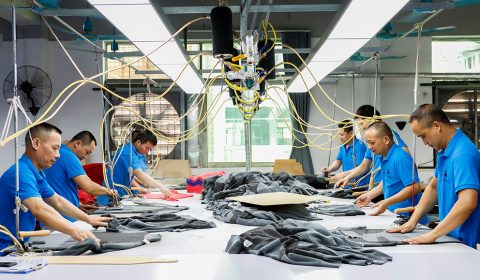Good sweaters require proper maintenance to extend life and maintain appearance
Sweaters are our warm and comfortable companions during the cold season, but in order to ensure that they stay with us for a long time, proper maintenance is crucial. Sweaters are often made with exquisite craftsmanship and high-quality raw materials, but if we do not take proper maintenance measures, they may lose their original soft texture, and even shrink and wrinkle. Therefore, the maintenance of the sweater is like the treatment of precious art, which requires patience and careful care.
First of all, let’s be clear that sweaters are not suitable for frequent machine washing. Machine washing is often too rough, which can easily lead to damage and shrinkage of sweater fibers. Hand washing, on the other hand, is a gentler option. Use cold water and special wool detergent, gently scrub to ensure that the detergent is fully penetrated and cleaned. After the cleaning is completed, gently absorb water with a towel, do not wring out hard, so as not to cause deformation.
Second, sweaters need to be extra careful when drying. The best way is to lay the sweater flat on a clean towel and try to restore its original shape. Avoid direct exposure to the sun and dry slowly in a cool, ventilated place. This avoids distortion and color fading caused by the sun’s rays and hot air.
Understanding the characteristics of different counts and needle numbers of sweaters, targeted to take the right maintenance methods, will help to extend the service life of sweaters, so that they always glow with charming luster.
Know the stitch count and count of the sweater
Count is an important index used to indicate the thickness of yarn or yarn. It is usually expressed in “count”, such as 40, 60, etc. The count is calculated by saying that if a pound of yarn is about 560 yards long, then 40 pieces of yarn is 40 pieces of yarn and the weight of the yarn can be pulled 560 by 40 yards in a pound. Therefore, the higher the count, the longer the length of yarn can be drawn per unit weight, and the finer the thickness.
The change of count directly affects the feel and appearance of the sweater. Sweaters made of higher count wool are more delicate and soft, suitable for making light spring and summer sweaters, while lower count wool is more suitable for making thick sweaters for winter warmth. Understanding the count helps us better match the season and individual wear needs when choosing sweaters.
The number of stitches is the number of stitches per inch in the area of the knitted fabric. Generally, a higher stitch count means that there are more stitches per unit length, so the fabric is finer. This directly affects the texture and elasticity of the sweater.
Sweaters with a high stitch count are usually more delicate and have a better fit, which is suitable for making some slim-fit designs or styles requiring higher comfort. However, sweaters with a high stitch count may be relatively fragile and require more careful care. Conversely, a sweater with a low stitch count may be thicker and stronger, making it suitable for making warm winter coats or knitted coats.
Understanding the stitch count not only helps in choosing the right sweater for the season and occasion, but also helps in proper maintenance to extend the service life of the sweater. High-quality sweaters are usually accompanied by a high stitch count, so the stitch count is an important reference standard when choosing and maintaining them.
Maintenance methods with different number of needles and counts
Low-count sweaters are more likely to produce hairballs during wearing and washing because of their thicker fibers. This may affect the appearance and feel of the sweater, so special care is needed.
Low-count sweaters are rougher and more sensitive to cleaning methods. The preferred method is hand washing to ensure gentle handling of the fibers. During the washing process, use a mild detergent, preferably a product designed for wool or coarse fibers, to avoid damaging the fiber structure.
Low-count sweaters are easily damaged in the kneading process, so avoid too intense kneading. When washing by hand, use gentle massage techniques to avoid rubbing hard, so as not to damage the fiber surface and reduce the possibility of fuzz.
Hand washing is the preferred washing method for low-count sweaters because it allows better control of the washing process and reduces mechanical damage. When washing by hand, it is very important to choose a mild detergent.
High count sweaters usually have a more delicate yarn, presenting a soft, comfortable texture. However, this also makes them relatively vulnerable to damage and requires more careful maintenance. First of all, be careful to avoid contact with sharp objects, so as not to appear on the surface of the sweater brushed or hooked. In addition, avoid wiping with metal accessories to prevent scratching the sweater surface. Regular inspection of the overall condition of the sweater and timely treatment of any small holes or worn parts are the key to maintaining the appearance of a high-count sweater for a long time.
Because high-count sweaters are more delicate, choosing the right way to wash them is crucial. The preferred method is hand washing to ensure more meticulous care. When choosing to use the washing machine, be sure to use the wool washing mode, as this mode will slow down the agitation rate during the washing process and reduce the mechanical damage to the sweater. When washing, choose a professional wool detergent and avoid ordinary cleaners containing bleach or strong alkaline ingredients, so as not to damage the fiber.
After washing, proper moisture treatment is essential for high-count sweaters. Use a clean, soft towel to gently absorb excess water and avoid rubbing or wringing it out. High-count sweaters are more likely to lose their shape due to excessive mechanical pressure, so gentle care is crucial. At the same time, avoid exposure to the sun, you can choose to lay flat in a well-ventilated place to dry, to ensure that the sweater returns to the best condition.
Through the above meticulous care steps, we can ensure that high count and stitch sweaters remain elegant and soft during use, and extend their service life.




 English
English Deutsch
Deutsch Français
Français Italiano
Italiano Español
Español Русский
Русский Polski
Polski Nederlands
Nederlands Svenska
Svenska

